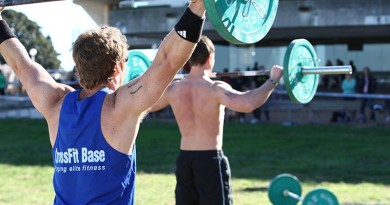Military Fitness – Part 34


I usually split my training fairly evenly between my garage and a couple of big commercial gyms.
Naturally, at the commercial gyms, I get to see other people training – and often see some ‘interesting’ things.
Now, before I go on, I would like to say that when I am watching someone else train, I try not to judge what they are doing because, without talking to them, I may not understand the reason they are doing something and they may have a very specific reason for doing it (although, by the look of a lot of the guys I see training, they have no idea what they are doing).
After observing this for the past few months and thinking about it a bit (and while doing a set of partial squats) I realised that, while many of the guys at big gyms are doing things which might not generally be a good idea, their methods often DO have a specific use and some of them are worth looking at in more detail.
 Couch to Commando by Don Stevenson is a 165-page e-book with programs in 6 different levels to progress anyone from couch potato to commando candidate.
Couch to Commando by Don Stevenson is a 165-page e-book with programs in 6 different levels to progress anyone from couch potato to commando candidate.
20% of proceeds from the sale of this e-book will be donated to Soldier On
Partial-range-of-motion work
Generally it is best to perform strength exercises through a full range of motion and so the majority of guys at the gym doing 1/2 or 1/4 (even 1/8 at one gym) reps of squat and bench are just deluding themselves.
However, partial-range-of-motion work on the big lifts is often useful for working on specific weaknesses and for learning to handle higher loads.
As an example, I quite like to do heavy partial squats for some high-rep sets once a week.
I will start with the bar on pins only a few inches below lockout and pile on an extra 40 to 60kg and do sets of 20 reps.
Then, each week, I will lower the pins by two inches and drop the weight and reps back a little.
These heavy squats then make anything up to about 90% feel light on your back!
Similarly, doing the same exercise with bench press can be very useful for developing lockout strength and confidence under a heavy weight.
The caveat on both these examples is that they are for a specific purpose and they should not be considered a substitute for full-range work.
They are also not appropriate until you are benching at least bodyweight and squatting 1.5x bodyweight because, up to that point, a basic linear progression of the full exercise is all that is needed.
Forced Reps
Along with partials, this is perhaps the most common thing I see at the gym.
Basically, a forced rep is when you complete as many reps as you can on your own and then your gym bro helps you through an extra rep or three or 15.
This method is a staple of bodybuilding programs where the aim is to get the muscle to complete fatigue, but is fairly rare in proper strength programs because it is not as specific to strength as most people think.
In gyms, forced reps are normally done very badly on bench press with the person lifting demonstrating horrible and dangerous technique because they have reached failure. But their bro is then helping them through a bunch of extra reps where they are doing most of the lifting.
Coaches derisively call this the ‘team bench press’ and it really misses the point of doing some forced reps.
I believe that if you are going to do forced reps then you should only do them occasionally and only then to break through a plateau.
Further, it is advisable to follow a few basic guidelines.
- Only perform a maximum of one to three forced reps.
- Only continue to perform forced reps if technique is sound.
- The spotter should ensure that the bar continues to move smoothly (even if slowly) without the bar stalling for long periods.
- The spotter should only be lifting 10-20% of the load at most. If the spotter is getting a workout too, then the forced reps need to stop!
Lots of isolation work
Most guys I see at the gym are doing 450 different isolation exercises for every part of their upper body, which is fine except that the same guys aren’t doing enough of the big basics to develop any real strength, and so their obsession with isolation exercises leads to lots of show but very little go.
Isolation exercises have their place.
A quick survey of top athletes shows that virtually everyone performs specific isolation work for their arms, chest, lower back, glutes, hamstrings etc, but NONE of them are doing this at the expense of time under the bar.
If you’ve got a specific weakness, like weak triceps or hamstrings, by all means go ahead and do some tricep pushdowns or hamstring curls, but don’t even think about doing them until after you’ve done your bench, squat or deadlift for the day!
.
.
.
.
.

.
.






